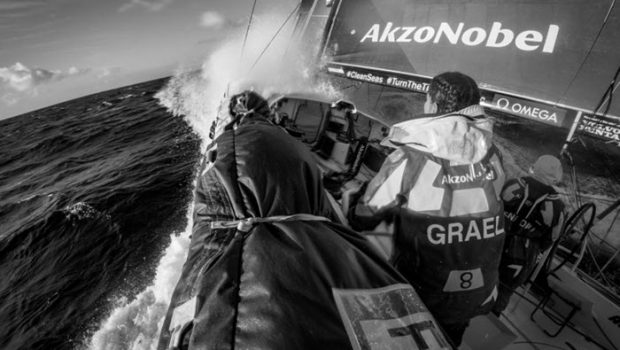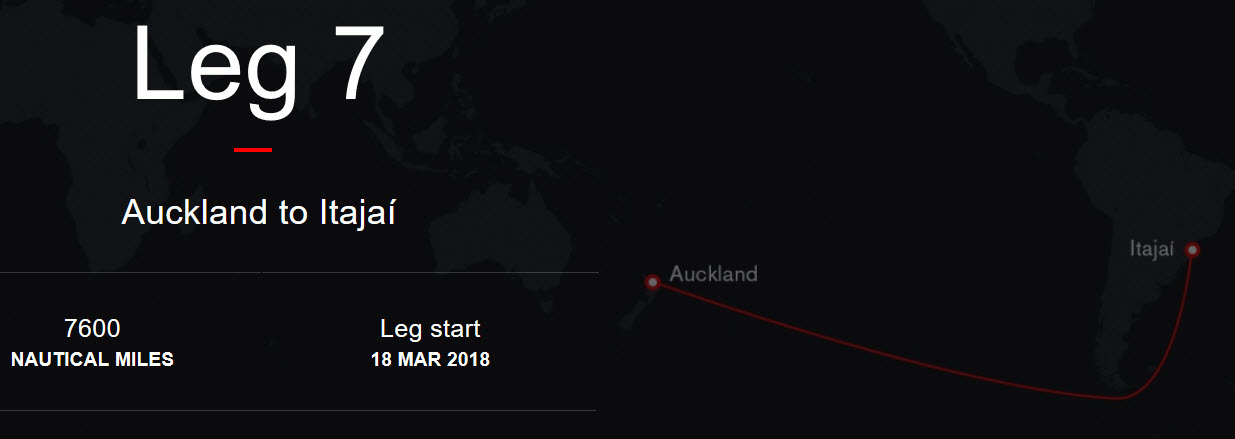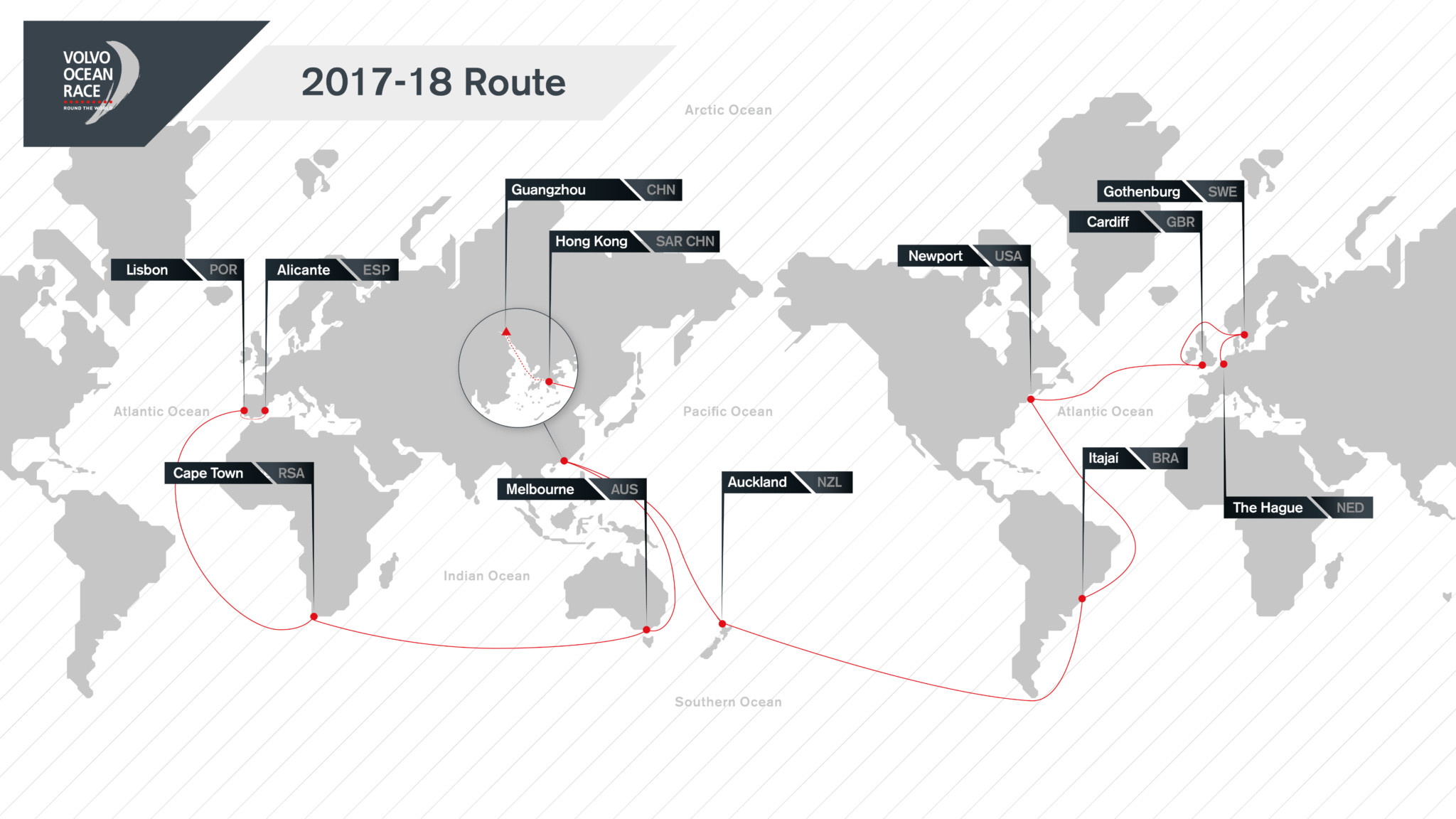Volvo Ocean Race: East after south
Published on March 21st, 2018
(March 21, 2018; Day 4) – The Volvo Ocean Race the teams have reached the Furious Fifties and made their turn to the east, pointing towards the famed Cape Horn in this leg from from Auckland (NZL) to Itajaí (BRA).
There has been little let-up for the seven teams as north-easterly winds of 20 and 30 knots has guaranteed rapid sailing conditions and similar boat speeds from the Volvo 65s.
Vestas 11th Hour Racing clocked off 500.2 nautical miles in the 24 hours leading up to the 0700 position report, with their six rivals all within 15 miles of the target.
Until now the race has been to get due south as fast as possible to skirt round the bottom of a big anticyclone, but today the teams – split on the water by 25 miles – started to swing round to the east as the ice exclusion zone quickly approaches.
The shortest, and therefore technically the quickest, route will see the fleet bounce along the exclusion zone, put in place by race management to keep the teams away from Antarctica’s icebergs.
Vestas had slipped to second place, having surrender the top spot to team AkzoNobel as the fleet blasts east.
“It’s still pretty tight – we’ve got Dongfeng and MAPFRE coming at us pretty quickly at the moment, and we can see Brunel’s light up to windward,” Akzonobel’s navigator Jules Salter explained.
“Everyone’s doing 22, 23 knots so we’re really only 10 or 15 minutes apart from each other. The sea state and the wind is changing all the time, and we’re just trying to find the right combination for the sails. The guys on deck have a lot of work on.”
The next challenge facing the teams comes in the shape of a monster depression brewing to the south containing winds in excess of 40 knots.
“There’s definitely some more wind coming, that’s for sure,” Salter added. “We’ll also have to start doing a few gybes and that’s going to be pretty tricky in those big winds and waves. The hardest bit is yet to come.”
Dongfeng Race Team skipper Charles Caudrelier knows the severity of what lies ahead.
“There will be five tough days to go until we reach Cape Horn,” Caudrelier said. “Five days is long in these conditions when you are close to the ice limit, in the coldest area, with many manoeuvres – it really is going to be very hard.
“We will really have to look after the boat and the sailors because there will be a lot of rough sea, a lot of wind and a lot of rotations. This is the worst because manoeuvres in these conditions and in the big seas are difficult, but we have no choice. This is it – the Great South.”
For Team Brunel, they are already dealing with setbacks.
“We had a couple of breakages on the first day,” Abby Ehler explained. “we’ve got a little tear in the J2 and our AIS isn’t working, which is a real hindrance not being able to see the rest of the fleet. We’re working our way through all these mishaps.”
COURSE: Starting on March 18, Leg 7 takes the teams from Auckland, New Zealand to Itajaí, Brazil. Race organizers choose to estimate the tactical distance for each leg rather than list the actual distance, an unusual decision that’s revealed once the race starts and the tracker lists the actual distance to finish. The VOR says Leg 7 is 7600 nm whereas the truth is more like 6623 nm with an ETA in Itajaí between April 4 and 6.
For crew lists … click here.
Race details – Tracker – Scoreboard – Race route – Facebook – YouTube
Leg 7 – Position Report (19:00 UTC)
1. Team AkzoNobel (NED), Simeon Tienpont (NED), 5404.4 nm DTF
2. Vestas 11th Hour Racing (DEN/USA), Charlie Enright (USA), 2.5 nm DTL
3. Dongfeng Race Team (CHN), Charles Caudrelier (FRA), 6.2 nm DTL
4. MAPFRE (ESP), Xabi Fernández (ESP), 6.5 nm DTL
5. Team Brunel (NED), Bouwe Bekking (NED), 6.8 nm DTL
6. Turn the Tide on Plastic (POR), Dee Caffari (GBR), 24.6 nm DTL
7. Team Sun Hung Kai/Scallywag (HKG), David Witt (AUS), 26.4 nm DTL
DTF – Distance to Finish; DTL – Distance to Lead
Overall Results (after 6 of 11 legs)
1. MAPFRE (ESP), Xabi Fernández (ESP), 39 points
2. Dongfeng Race Team (CHN), Charles Caudrelier (FRA), 34
3. Team Sun Hung Kai/Scallywag (HKG), David Witt (AUS), 26
4. Team AkzoNobel (NED), Simeon Tienpont (NED), 23
5. Vestas 11th Hour Racing (DEN/USA), Charlie Enright (USA), 23
6. Team Brunel (NED), Bouwe Bekking (NED), 20
7. Turn the Tide on Plastic (POR), Dee Caffari (GBR), 12
2017-18 Edition: Entered Teams – Skippers
• Team AkzoNobel (NED), Simeon Tienpont (NED)
• Dongfeng Race Team (CHN), Charles Caudrelier (FRA)
• MAPFRE (ESP), Xabi Fernández (ESP)
• Vestas 11th Hour Racing (DEN/USA), Charlie Enright (USA)
• Team Sun Hung Kai/Scallywag (HKG), David Witt (AUS)
• Turn the Tide on Plastic (POR), Dee Caffari (GBR)
• Team Brunel (NED), Bouwe Bekking (NED)
Background: Racing the one design Volvo Ocean 65, the 2017-18 Volvo Ocean Race begins in Alicante, Spain on October 22 2017 with the final finish in The Hague, Netherlands on June 30 2018. In total, the 11-leg race will visit 12 cities in six continents: Alicante, Lisbon, Cape Town, Melbourne, Hong Kong, Guangzhou, Auckland, Itajaí, Newport, Cardiff, Gothenburg, and The Hague. A maximum of eight teams will compete.
Source: Volvo Ocean Race












 We’ll keep your information safe.
We’ll keep your information safe.